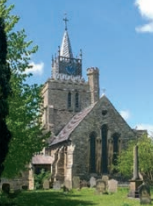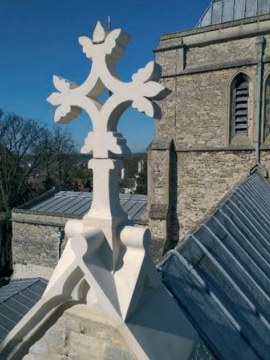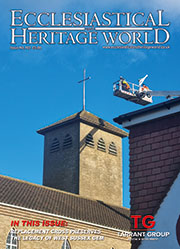Co-ordination allows numerous repairs to be carried out at once
 Two contracts were recently undertaken together as a single project at the Grade One-listed church of St Mary in Aylesbury. The works included stonework repairs, repointing, leadwork repairs, window restoration, the introduction of isothermal glazing, furniture and flooring repairs, as well as renewal of the boiler flue and various other sundry works. St Mary’s is a nationally important church. The ancient edifice has Saxon origins and has undergone many visible periods of growth, alteration and restoration – resulting in the characterful and imposing church we see today. The church dominates the town centre of Aylesbury and is situated in a walled churchyard ringed by historic buildings which, in effect, creates a setting akin to a cathedral close.
Two contracts were recently undertaken together as a single project at the Grade One-listed church of St Mary in Aylesbury. The works included stonework repairs, repointing, leadwork repairs, window restoration, the introduction of isothermal glazing, furniture and flooring repairs, as well as renewal of the boiler flue and various other sundry works. St Mary’s is a nationally important church. The ancient edifice has Saxon origins and has undergone many visible periods of growth, alteration and restoration – resulting in the characterful and imposing church we see today. The church dominates the town centre of Aylesbury and is situated in a walled churchyard ringed by historic buildings which, in effect, creates a setting akin to a cathedral close.
The 2015 and 2020 quinquennial inspections by Daniel Benson of Ablett Architects highlighted several serious issues on a general level, including unsafe stonework on the clerestory walls and aisle parapets, buckled glass in the chancel windows and defects to the lead roofs. Other issues more specific to the fabric of the church included a stone gable cross – taken down as unsafe a few years previously – an unsafe and unlined boiler flue and badly decayed chimney and, in the chancel, damaged misericords and small areas of missing floor tiles. A project was put together that would address urgent stonework repairs at specific, concentrated areas – which gathered together and incorporated other necessary works which could sensibly be undertaken using shared access scaffolding. Having scaffolding at specific areas would allow for works other than the primary need to repair stonework.
 The new stone cross in situ on the chancel gable
The new stone cross in situ on the chancel gable
Generally, much of the clerestory stonework was badly weathered and decayed, with several areas missing and others cracking away from the walls. Some jamb and arch stones were clunch (chalk), which had decayed by more by than half the stones’ depth, while in other areas the stones were cracking and pulling away from the walls. All the window surrounds were carefully surveyed and detailed drawings were made of the different profiles. The project had a long gestation period, which allowed for thorough investigations and research by the architect to inform the detailing and specifications. That included analysis of the walling stone and identifying suitable replacements. A source of the correct walling stone was found at a disused quarry on a nearby farm. For replacement ashlar stone, Hartham Park stone was chosen for durability, the existing being a combination of different stones, including very soft clunch.
Funding for the work was made possible by the happy convergence of several events, including a successful fundraising drive by the parish, the obtaining of a substantial grant from the COVID Recovery Fund and the Church Commissioners’ commitment to their liability for chancel repairs. The project drew together a team of specialists and experts with whom the architect was familiar and had worked with previously on other, similar projects. The structural engineer was Robert Wallbank, who advised on the existing structure which could, for the first time in decades, be examined up close. The buckled and fading chancel windows were fully surveyed and restored by Martin Johnson Stained Glass (York) Ltd. The heating and flue lining works were overseen by David Gadsdon of Environmental Engineering Partnership. The main contractor was Universal Stone Ltd, whose team of expert masons demonstrated the skills and craftsmanship for which the firm is known.
Within the chancel area, misericord repairs were undertaken by Gavin Dingle of D & F Polishing, who even gave a tutorial to the parish volunteers on how to refresh and polish woodwork generally. The successful completion of the work on time and on budget was a testament to the planning and subsequent attention to the processes on site. The whole project was commemorated by the Bishop of Buckingham, the Rt Rev Dr Alan Wilson, who publicly rededicated the new stone cross on the chancel gable – which represented a visible testament to the success of the larger project – in a public ceremony.
Instrumental to the success of the project was the inspirational leadership of the rector, Fr Doug Zimmerman. The project is a lesson in sustainability. The historic church has been successfully repaired and made secure for successive generations to appreciate and enjoy, and it will be able to continue its mission as a focus for worship within the Aylesbury community.














